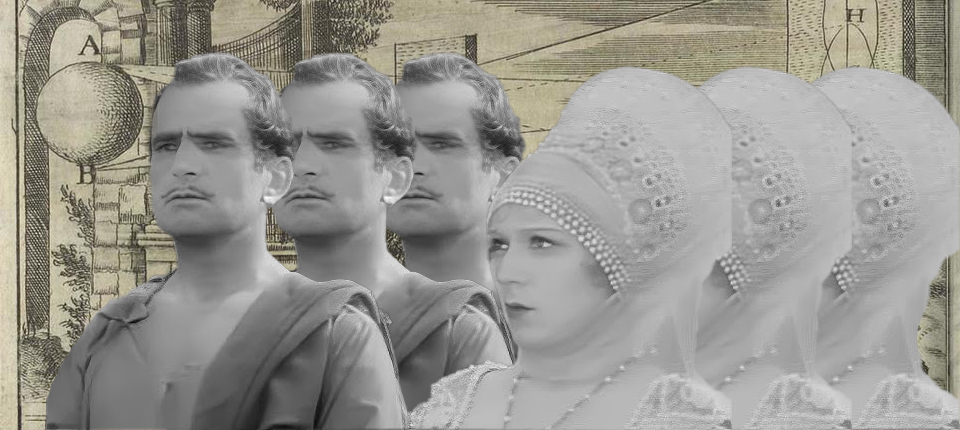Thud! A pickaxe striking stone. Zzzzzz! A vagrant snoring. Swish! A broom sweeping the sidewalk. Brrrring! An alarm clock ringing. Waaaaah! A baby crying. Woompf! A woman shaking out her laundry. These are the sounds of Paris in the morning. At first they seem perfectly ordinary, just what you’d expect to hear in a waking city, but as they accumulate you start to notice something odd: they’re harmonizing, creating their own music, a symphony of the street. No, you’re not hallucinating. You’re watching Love Me Tonight (1932), the luminous musical directed by Rouben Mamoulian.
Today Mamoulian is largely overshadowed by his more prolific peers, but, as Kurt Jensen reminds us in a goodish (if somewhat slim) biography of the director, he was for a time one of the most innovative film-makers in the world. He was the first director of the talkie era to understand that sounds needn’t be the handmaidens of images; they could be equal partners. The street symphony that opens Love Me Tonight is in fact only the cleverest sequence in the movie. The cleverest, for my money, is the one that follows a few minutes later, as the tailor played by Maurice Chevalier begins to sing “Isn’t It Romantic?”. His customer, a portly bridegroom-to-be, picks up the tune and carries it outside, where he passes it to a mustachioed man in a taxi, who in turn hands it off to a trainload of soldiers, who sing it as they march through the countryside, and thus the song spreads, from person to person, like a melodic contagion, until it reaches the ear of the princess played by Jeanette MacDonald, who will soon fall in love with our tailor hero.
Mamoulian’s early success was due in large part to the fact that he had no experience in silent cinema. Born in Tiflis (now Tbilisi), Georgia, in 1897, he was a refugee twice over when he moved to America in 1923. He had studied at the Moscow Art Theatre, the forefather of method acting, but realism didn’t appeal to him. “I don’t believe in naturalism on the screen or the stage”, he once explained. “I believe in stylization, which if properly done comes over as a greater truth than reality.” He knew next to nothing about cinema when he first came to Hollywood – one of the many directors lured away from Broadway in the early days of sound – but this made him an avid experimenter. His use of shadowplay in Applause (1929) prefigures Michael Curtiz’s use of the same technique in Captain Blood (1935), and the subjective point of view that he employs in Dr Jekyll and Mr Hyde (1931) anticipates the POV shots that would, decades later, be used in horror films such as Peeping Tom (1960), Black Christmas (1974) and Halloween (1978). Indeed, Applause was so far ahead of its time, technically speaking, that some critics refused to accept that Mamoulian had directed it on his own. “To ask one to believe that a stage director on his first picture try could turn out this film as it has been turned out is asking one to believe as big a lot as a studio occupies”, Variety opined.
Later critics weren’t always so impressed by his work. “Mamoulian’s tragedy”, Andrew Sarris wrote in 1968, “is that of the innovator who runs out of innovations.” Sarris isn’t wrong, per se, but tragedy is too strong a word. Mamoulian’s career didn’t implode, the way Michael Cimino’s did, so much as gradually deflate. How and why is something that Jensen never satisfactorily explains. In part it was clearly temperamental. Between 1944 and 1961 Mamoulian was fired from two films and resigned from a third. In part it was just bad luck. He could be a stubborn creature, infuriating producers, but the problems that beset Cleopatra (1963), for instance – an unfinished script, a sickly star, a brutally cold London winter – were beyond his control. As his career in Hollywood faltered he returned to Broadway, scoring hits with Oklahoma! (1943) and Carousel (1945).
The title of Kurt Jensen’s book, Peerless, makes Mamoulian sound unequalled. In truth he had many equals and a handful of betters, among them Ernst Lubitsch, the director to whom he is most often compared. He wasn’t so much peerless as sui generis. While one can imagine Mamoulian making many of Lubitsch’s films, one can hardly see Lubitsch directing City Streets (1931), the gangster picture Mamoulian made with Gary Cooper, or his swashbuckling adventure The Mark of Zorro (1940), starring Tyrone Power. Mamoulian wasn’t the most talented director of his generation, or the most consistent, but he was one of the most versatile, always pushing himself and the art of cinema in new directions.
Graham Daseler is a film editor and animator. He lives in Los Angeles
The post Sound and vision appeared first on TLS.

 By Times Literary Supplement | Created at 2024-10-29 21:41:39 | Updated at 2024-10-30 09:25:57
6 days ago
By Times Literary Supplement | Created at 2024-10-29 21:41:39 | Updated at 2024-10-30 09:25:57
6 days ago



